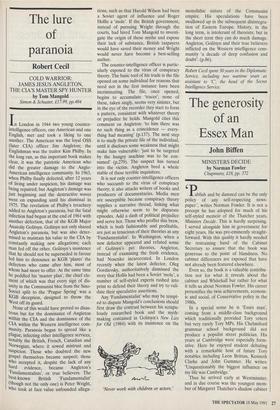The lure of paranoia
Robert Cecil
COLD WARRIOR: JAMES JESUS ANGLETON, THE CIA'S MASTER SPY HUNTER by Tom Mangold Simon & Schuster, £17.99, pp.404 In London in 1944 two young counter- intelligence officers, one American and one English, met and took a liking to one another. The American was the loyal OSS (later CIA) officer Jim Angleton; the Englishman was the traitor Kim Philby. In the long run, as this important book makes clear, it was the patriotic American who did the greater damage to the Anglo- American intelligence community. In 1963, when Philby finally defected, after 12 years of living under suspicion, his damage was being repaired; but Angleton's damage was just beginning and the destructive waves went on expanding until his dismissal in 1975. The revelation of Philby's treachery added to Angleton's paranoia, but the fatal Infection had begun at the end of 1961 with another defection, that of the KGB Major Anatoliy Golitsyn. Golitsyn not only shared Angleton's paranoia, but was also deter- mined to maintain his value to the CIA by constantly making new allegations; each man fed off the other. Golitsyn's insistence that he should not be superseded in favour led him to denounce as KGB 'plants' the defectors who came after him, most of whom had more to offer. At the same time he peddled his 'master plan', the chief ele- ment of which was that every sign of dis- unity in the Communist bloc from the Sino- Soviet split to the 'Prague Spring' was a KGB deception, designed to throw the West off its guard. None of this would have proved so disas- trous but for the dominance of Angleton within the CIA and the dominance of the CIA within the Western intelligence com- munity. Paranoia began to spread like a Plague, infecting other intelligence services, notably the British, French, Canadian and Norwegian, where it sowed mistrust and suspicion. Those who doubted the new gospel themselves became suspect; those who accepted it, despite the lack of any hard evidence, became Angleton's Fundamentalists', or true believers. The best-known British 'Fundamentalist' (though not the only one) is Peter Wright, who took at face value unfounded allega- tions, such as that Harold Wilson had been a Soviet agent of influence and Roger Hollis a 'mole'. If the British government, instead of pursuing Wright through the courts, had hired Tom Mangold to investi- gate the origin of these myths and expose their lack of substance, British taxpayers would have saved their money and Wright would never have become a best-selling author.
The counter-intelligence officer is partic- ularly exposed to the virus of conspiracy theory. The basic tool of his trade is the file opened on some individual for reasons that need not in the first instance have been incriminating. The file, once opened, begins to accumulate `traces'; none of these, taken singly, seems very sinister,. but in the eye of the recorder they start to form a pattern, consistent with whatever theory or prejudice he holds. Mangold cites this comment on Angleton: 'to him there was no such thing as a coincidence — every- thing had meaning' (p.137). The next step is to study the private life of the individual, until it discloses some weakness that might make him vulnerable: 'just to be targeted by the hungry machine was to be con- sumed' (p.279). The suspect has turned into the victim. Angleton bred a whole stable of these terrible inquisitors.
It is not only counter-intelligence officers who succumb to the virus of conspiracy theory; it also attacks writers of books and producers of documentaries. Media men are susceptible because conspiracy theory supplies a narrative thread, linking what might otherwise seem to be disparate episodes. Add a dash of political prejudice and serve hot. Those who proffer this brew, which is both fashionable and profitable, are just as tenacious of their theories as any `Fundamentalist'. In Washington, when a new defector appeared and refuted some of Golitsyn's pet theories, Angleton, instead of examining the fresh evidence, had Nosenko incarcerated. In London recently when the latest defector, Oleg Gordievsky, authoritatively dismissed the story that Hollis had been a Soviet 'mole', a number of self-styled experts rushed into print to defend their theory and try to vali- date their speculative assertions. Any 'Fundamentalist' who may be tempt- ed to dispute Mangold's conclusions should first draw the contrast between his scrupu- lously researched book and the myth- making contained in Golitsyn's New Lies for Old (1984) with its insistence on the 'Never work with children or actors.' monolithic nature of the Communist empire. His speculations have been swallowed up in the subsequent disintegra- tion of Eastern Europe. History, in the long term, is intolerant of theorists; but in the short term they can do much damage. Angleton, Golitsyn and their true believers inflicted on the Western intelligence com- munity 'a decade of deep confusion and doubt'. (p.86).
Robert Cecil spent 30 years in the Diplomatic Service, including two wartime years as assistant to 'C', the head of the Secret Intelligence Service.


























































 Previous page
Previous page